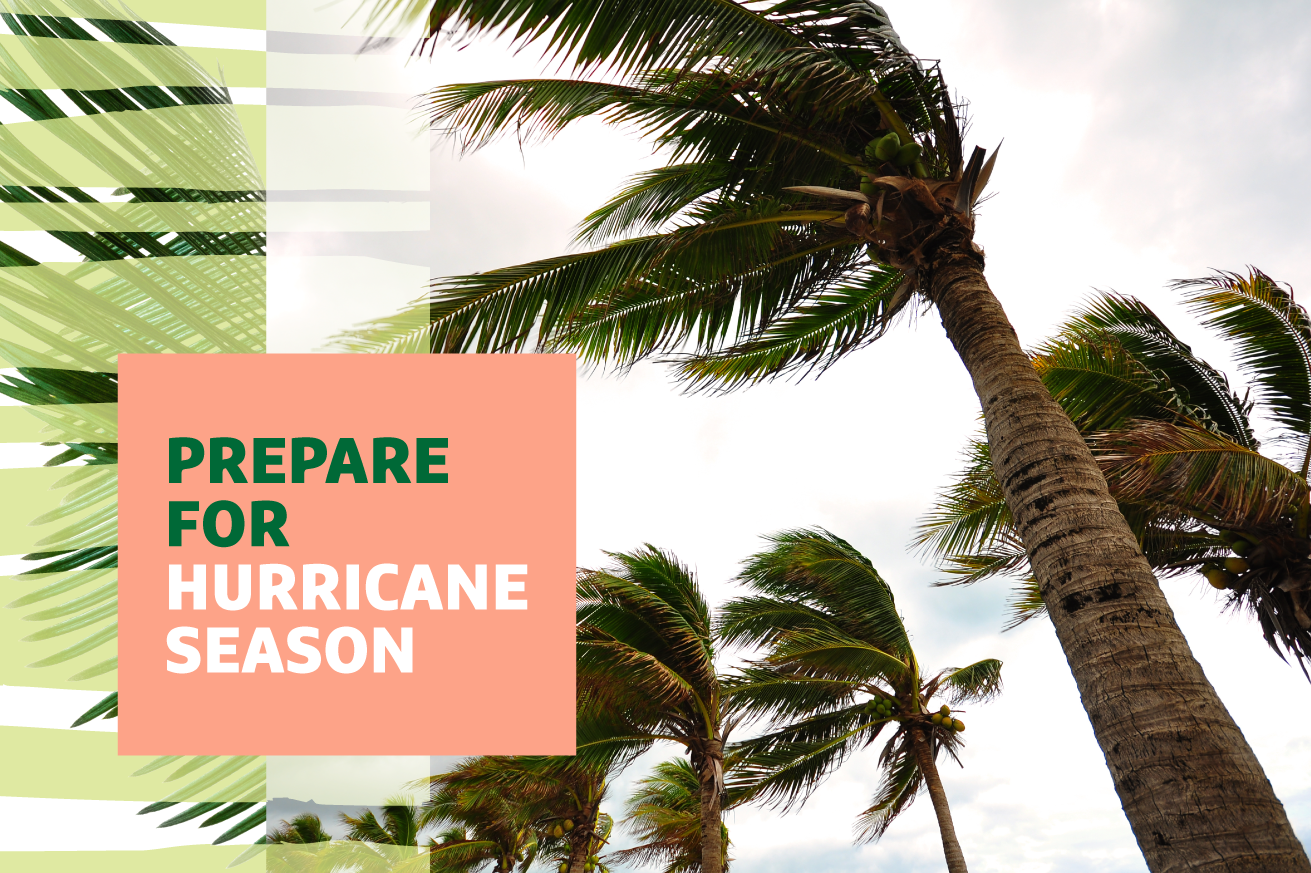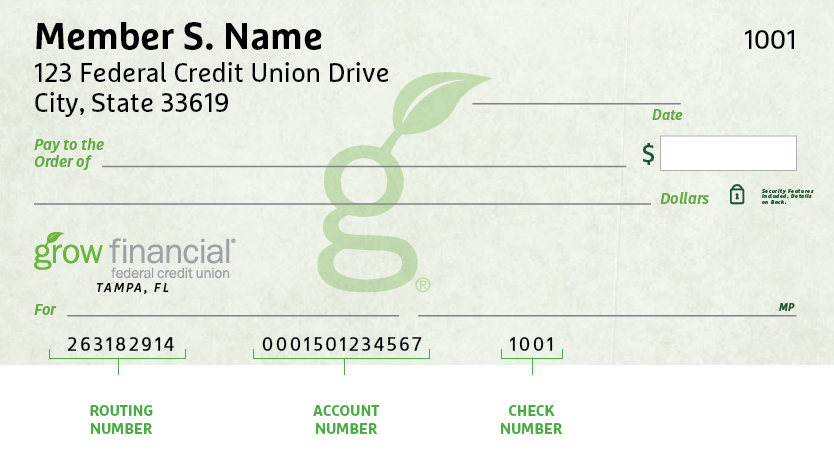- Personal
- Membership
- Membership
- Rates & Fees
- Checking
- Checking
- Personal Loans
- Personal Loans
- Wealth Management
- Investment Services
- Financial Advisors
- Resource Center
- Business

June 4, 2024
Get Ready for Hurricane Season in 4 Steps
With hurricane season around the corner, now is the right time to prepare. Hurricanes and other weather emergencies can cause stress and uncertainty, especially in flood-prone and coastal areas. Being prepared will help give you peace of mind and keep yourself and your family safe. Make sure you add these four things to your preparation list before a storm hits:
1. Get physically prepared.
When it comes to riding out stormy weather, getting your physical supplies together is key:
- Gather enough shelf-stable food and drinking water for your family and pets. Generally, one gallon of water per person per day, with enough to last five to seven days, is recommended.
- Purchase supplies now to avoid the pre-storm rush. If you’re considering getting a generator or other in-demand hurricane preparation products, think about getting them sooner rather than later.
- Know your evacuation zone and routes. Keep an eye on your area’s weather alerts before, during and after a major storm. (It is smart to keep an emergency weather alert radio with extra batteries around.)
- Photograph your most valuable possessions. Documentation can help with insurance companies should you lose any items in a severe weather event.
- Review your family emergency plan together. Make sure everyone knows how you will communicate, where you will meet and what steps you will take in the event of a hurricane or other emergency.
For additional advice on physical preparation, the National Weather Service has an excellent resource library with instructions on how to prepare for all kinds of weather emergencies, including hurricanes and tropical storms.
2. Stash an emergency fund.
While you’re preparing physically, remember to prepare financially as well. It’s generally a wise savings goal to have three to six months of living expenses in liquid funds you can easily access, such as a Grow Money Market Account, to cover the cost of any unforeseen situations. That’s especially true after a weather emergency. It’s also a good idea to keep some actual cash on hand in a secure location. You never know when ATMs or terminals might be temporarily unavailable after extreme weather events, so stash some cash just in case.
3. Check your insurance coverage.
Review your current insurance policies, including homeowners, renters and auto insurance, to ensure you’re sufficiently covered in case of damage or loss. Increase your coverage limits, if necessary, and be aware of out-of-pocket expenses and deductibles.
Consider adding a flood insurance policy. No one in the history of post-hurricane cleanup has ever said, “I wish I didn’t have that flood insurance.” Don’t wait until it’s too late to add flood insurance coverage for your home. If you’re looking for insurance policies, check out Quorum Insurance LLC for a free, no-obligation quote.* Quorum will do the work for you to compare policies and help you find the right one.
4. Keep important documents safe.
It’s crucial to keep important documents safe and accessible — things like household identification, financial and legal documentation, and medical information — whether in a safe deposit box, secure cloud storage or another secure place during a weather emergency. Use this FEMA checklist to learn more about safeguarding critical documents and valuables.
Try FEMA’s Emergency Financial First Aid Kit
In addition to the four essential steps above, we recommend reviewing the Emergency Financial First Aid Kit — a joint publication from Operation Hope and FEMA that will help you prepare financially and reduce the impact of disasters on you and your family.
By completing preparation tasks before a hurricane hits, you’ll be well-prepared to face any challenges and protect what matters most. Remember, preparedness is key!
To stay up to date on the latest financial literacy content, follow us on Facebook and Instagram.
*Quorum Insurance LLC is an affiliate of Grow Financial. Insurance products purchased through Quorum Insurance LLC are not deposits of Grow Financial and are not protected by NCUA. They are not an obligation of or guaranteed by Grow Financial and may be subject to risk. Business conducted with Quorum Insurance LLC is separate and distinct from any business conducted with Grow Financial. Grow Financial is in no way responsible for the services provided through this program.
Posted In:
How to Find Your Routing & Account Numbers
When you make a payment online, by phone or on a mobile device, you may be asked for our routing number and your checking account number. Credit unions and banks use these numbers to identify accounts and make sure money gets where it’s supposed to be. You’ll also need to provide your routing and checking account numbers for:
- Direct deposits
- Electronic checks
- Military allotments
- Wire transfers
Where to Find Your Routing & Checking Account Numbers
Your personal checks include both our routing number and your account number, as shown on the Grow check example below.

Don’t have a Grow check? No worries.
Visit any Grow store and ask for a Direct Deposit Form. It lists both your routing number and checking account number.
Making a Loan Payment
Incorrect Phone Number Alert
We’ve identified an incorrect phone number listed in a letter sent to a select group of new members with auto loans. The incorrect number is NOT affiliated with Grow. Please be sure to use our official phone number, 800.839.6328, which you can verify on our Contact Information page. For your security, keep your personal information safe and avoid sharing it over the phone, email or text message. We will never ask you for your credit or debit card security code, expiration date or PIN, login security codes, or your online banking password.
When it comes to making payments, we try to make it as painless as possible to pay your loan every month. We have several different ways to pay, including convenient online options.
Pay Online
You have two ways to pay online by transferring funds from another bank or credit union.
- Grow Online Banking (Preferred payment method for any loan)
This is the simplest way to pay your loan. You can make one-time payments or set up automatic recurring payments in Grow Online Banking. Once you log in, select “Transfer/Payments” from the menu. If you’re not enrolled in Grow Online Banking yet, you can set up your account in just a few minutes.
Log In
- Debit Card or ACH (Available for auto, personal loans and HELOCs)
Note: ACH and debit card payments are not available for credit cards or most mortgages, except HELOCs.
We accept ACH payments with no additional fees, consumer Mastercard® and Visa® debit cards with a convenience fee of $4.95, or commercial Mastercard® and Visa® debit cards with a convenience fee of 2.95% of the payment amount. To get started with an online ACH or debit card payment, select Pay Now below.
Pay Now
Pay by Mail
You can also pay any Grow loan by check through the mail. Please remember to include your account number and Grow loan number on the check. (For credit card payments, please do not write your 16-digit credit card number on the check, which can cause a delay in processing the payment.)
Address for auto, credit card, personal loan and HELOC payments:
Grow Financial Federal Credit Union
P.O. Box 75466
Chicago, IL 60675-5466Address for personal first or second mortgages and home equity payments:
Grow Financial Federal Credit Union
P.O. Box 11733
Newark, NJ 07101-4733You Are About To Leave GrowFinancial.org
At certain places on this site, there are links to other websites. Grow Financial Federal Credit Union does not endorse, approve, represent, certify or control those external sites. The credit union does not guarantee the accuracy, completeness, efficacy, timeliness or accurate sequencing of the information contained on them. You will not be represented by Grow Financial Federal Credit Union if you enter into a transaction. Privacy and security policies may differ from those practiced by the credit union. Click CONTINUE if you wish to proceed.
